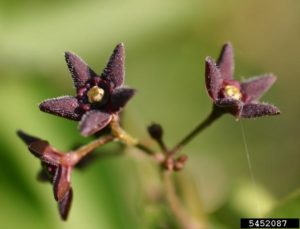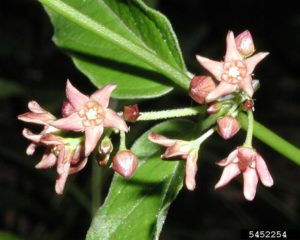black swallow-wort; photo by Leslie J. Mehrhoff, University of Connecticut
Help is on the way!
With funding support through the Northeast IPM Partnership, University of Rhode Island entomologist Richard Casagrande has been leading a team to find biological control agents for two invasive plant species. The target species, black swallow-wort (Vincetoxicum nigrum) and pale swallow-wort (Vincetoxicum rossicum), are native to Europe and members of the milkweed family Apocynaceae (previously Asclepiadaceae). In the U.S., their vigorous growth overtakes and smothers small trees, shrubs and other native plants and threatens the survival of the monarch butterfly whose larvae rely on milkweed for their development. They are currently found in the northeastern and mid-Atlantic states but could spread much farther.
(See Faith’s earlier blog about USDA speeding up approvals of biocontrols for invasive plants here.
U.S. native swallow-wort species belong to the genus Cynanchum and include a dozen or so rare and endangered plant species. It was essential to consider these native species in the investigations. Feeding tests would need to show definitively that the potential biocontrol species would not attack native swallow-worts or other native members of the milkweed family. And, Jennifer Dacey, Casagrande’s graduate student, wanted to find out how well the exotic swallow-worts might provide for monarch butterflies. The results were alarming. All of the monarch larvae died when hatching on black swallow-wort. “They stopped eating after a single bite,” says Casagrande.
pale swallow-wort; photo by Leslie J. Mehrhoff, University of Connecticut
Why biological control?
Small infestations of invasive swallow-wort, seedlings and young plants can be pulled up by hand, mature plants can be dug up, and frequent mowing can suppress populations in fields. However, most infestations are too extensive to control by hand. Systemic herbicides – those that are carried through the plant to the roots — can be used to control large infestations, using foliar sprays. Several years of treatment will likely be needed due to the persistence of swallow-wort seeds. These efforts can be part of an overall Integrated Pest Management strategy but the best long-range solution is biological control. Biocontrol relies on finding herbivores that have coevolved to feed on specific invasive plants in their native range that will not have a significant impact on non-target species. Graduate student Aaron Weed worked with Swiss scientists to identify a handful of specialist plant herbivores, mainly beetles and moths that evolved with black swallow-wort and pale swallow-wort in their native ranges in Europe and were highly unlikely to feed on other plant species.
Approval process.
All biological control agents must be approved for release by the U.S. Department of Agriculture, Animal and Plant Health Inspection Service (APHIS). APHIS sets up a Technical Advisory Group, or “TAG”, to review the research on feeding tests conducted by the researchers, called “no-choice” tests. Potential biocontrol agents are tested for feeding on an extensive selection of native plant species and their relatives to ensure the agents are specific to the target species and won’t pose a threat to agriculture or to rare, threatened or endangered species or to other native species. The TAG list includes, naturally, most native milkweed relatives and even species more distantly related.
“Luckily, none of our native plants is closely related to the [invasive]swallow-worts,” says Casagrande. “That makes [swallow-wort] a great candidate for classical biological control. The Tag list also includes a suite of Eurasian plants you might expect these specialists to nibble at now and then, and even plants that could host these specialists’ relatives. The bar is high for these no-choice tests: biocontrols must prove they’ll die before they switch.”
Casagrande’s team examined five possible biocontrol specialists in their quarantine lab, including two European moth species (Hypena opulenta and Abrostola asclepiadis) that feed on swallow-wort leaves in their native range. The researchers wanted to be sure these insects wouldn’t jump to non-target plants on the TAG list, since the last thing anyone wants is a new pest dominating the landscape, threatening agriculture, native ecosystems, and rare plants.
Results?
Both leaf-eating moths “passed the acid test,” says Casagrande. However, scientists have only petitioned for and received approval for Hypena opulenta, which was approved by the USDA in September 2017. They may seek approval for Abrostela in the future but for now are focused on rearing, releasing, and studying the effectiveness of Hypena. Releases in Canada started in 2013 when Hypena was approved there. Since then, it has established and spread but it is too soon to evaluate its effectiveness.
Releases in the U.S.
Hypena opulenta was released on Naushon Island, Massachusetts, in early September 2017 – the only release in the United States – where both black and pale swallow-wort occur. The field release was carried out by placing about 400 larvae in each of 4 large cages containing both swallow-wort species in sun and shade locations. The larvae will be allowed to grow and develop in the cages for a little while before the cages are opened to allow the larvae to escape and start establishing on the island.
Next steps?
Funding will be sought to support rearing of Hypena at University of Rhode Island and other locations in the U.S. Dr. Lisa Tewksbury, Manager of Biological Control at URI, is running the program. It will take a few years to get to the point of having sufficient moths to distribute widely. Best practices for releasing and monitoring will be developed.
Thanks to the Northeast IPM Partnership and the interest and dedicated efforts of Casagrande and his research team, we now have the most effective tool to use against two highly invasive plant species that will also protect our native species and natural ecosystems.
Posted by Jil Swearingen
Jil recently retired from the federal government and works as an invasive species consultant. She has 28 years of experience working on invasive species at the county, regional and national level in areas of education, outreach and management. Jil initiated and co-founded the Mid Atlantic Invasive Plant Council and serves on the board. Jil serves as the Coordinator for the Mid Atlantic Early Detection Network, a project she initiated and co-developed, and she continues to serve as Chair for the Plant Conservation Alliance’s Alien Plant Working Group and manager of the Weeds Gone Wild website. Jil is lead author of the book, Plant Invaders of Mid-Atlantic Natural Areas. She was recently elected to serve on the Board of Directors of the Maryland Native Plant Society
We welcome comments that supplement or correct factual information, suggest new approaches, or promote thoughtful consideration. We post comments that disagree with us — but not those we judge to be not civil or inflammatory.

